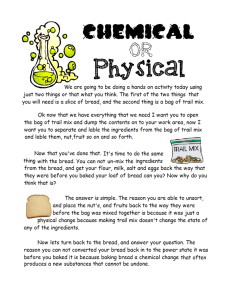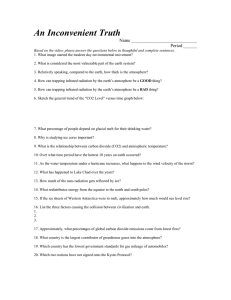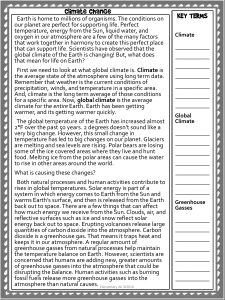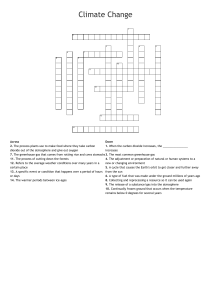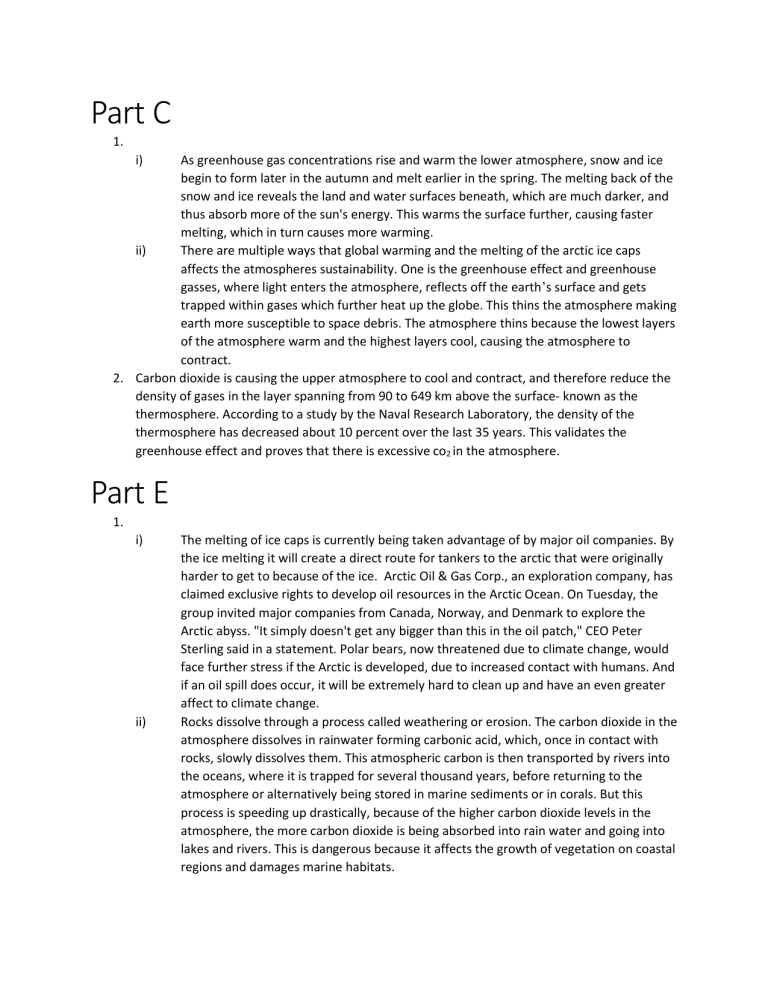
Part C 1. i) As greenhouse gas concentrations rise and warm the lower atmosphere, snow and ice begin to form later in the autumn and melt earlier in the spring. The melting back of the snow and ice reveals the land and water surfaces beneath, which are much darker, and thus absorb more of the sun's energy. This warms the surface further, causing faster melting, which in turn causes more warming. ii) There are multiple ways that global warming and the melting of the arctic ice caps affects the atmospheres sustainability. One is the greenhouse effect and greenhouse gasses, where light enters the atmosphere, reflects off the earth’s surface and gets trapped within gases which further heat up the globe. This thins the atmosphere making earth more susceptible to space debris. The atmosphere thins because the lowest layers of the atmosphere warm and the highest layers cool, causing the atmosphere to contract. 2. Carbon dioxide is causing the upper atmosphere to cool and contract, and therefore reduce the density of gases in the layer spanning from 90 to 649 km above the surface- known as the thermosphere. According to a study by the Naval Research Laboratory, the density of the thermosphere has decreased about 10 percent over the last 35 years. This validates the greenhouse effect and proves that there is excessive co2 in the atmosphere. Part E 1. i) ii) The melting of ice caps is currently being taken advantage of by major oil companies. By the ice melting it will create a direct route for tankers to the arctic that were originally harder to get to because of the ice. Arctic Oil & Gas Corp., an exploration company, has claimed exclusive rights to develop oil resources in the Arctic Ocean. On Tuesday, the group invited major companies from Canada, Norway, and Denmark to explore the Arctic abyss. "It simply doesn't get any bigger than this in the oil patch," CEO Peter Sterling said in a statement. Polar bears, now threatened due to climate change, would face further stress if the Arctic is developed, due to increased contact with humans. And if an oil spill does occur, it will be extremely hard to clean up and have an even greater affect to climate change. Rocks dissolve through a process called weathering or erosion. The carbon dioxide in the atmosphere dissolves in rainwater forming carbonic acid, which, once in contact with rocks, slowly dissolves them. This atmospheric carbon is then transported by rivers into the oceans, where it is trapped for several thousand years, before returning to the atmosphere or alternatively being stored in marine sediments or in corals. But this process is speeding up drastically, because of the higher carbon dioxide levels in the atmosphere, the more carbon dioxide is being absorbed into rain water and going into lakes and rivers. This is dangerous because it affects the growth of vegetation on coastal regions and damages marine habitats. iii) The geosphere won’t be able to sustain itself because with the ice caps melting the albedo, or reflectivity of the earth’s surface decreases, causing more solar energy to be absorbed and increasing temperatures. With no ice the earth will absorb 30% more solar energy. As sea levels rise, coastal habitats will flood, erode, and be destroyed. Once protective sea ice melts, new land is exposed to erosion. Sea ice is melting at 9% per decade. Land will flood and forests will be unable to root themselves, and have already started to rapidly disappear. 2. The melting of the ice caps will critically effect the geosphere and with constant heating and erosion, coastal habitats won’t be able to sustain themselves. If the global warming continues to get worse the geosphere will not be able to repair itself and could possibly be flooded with water, as ice melts 9% per decade.
